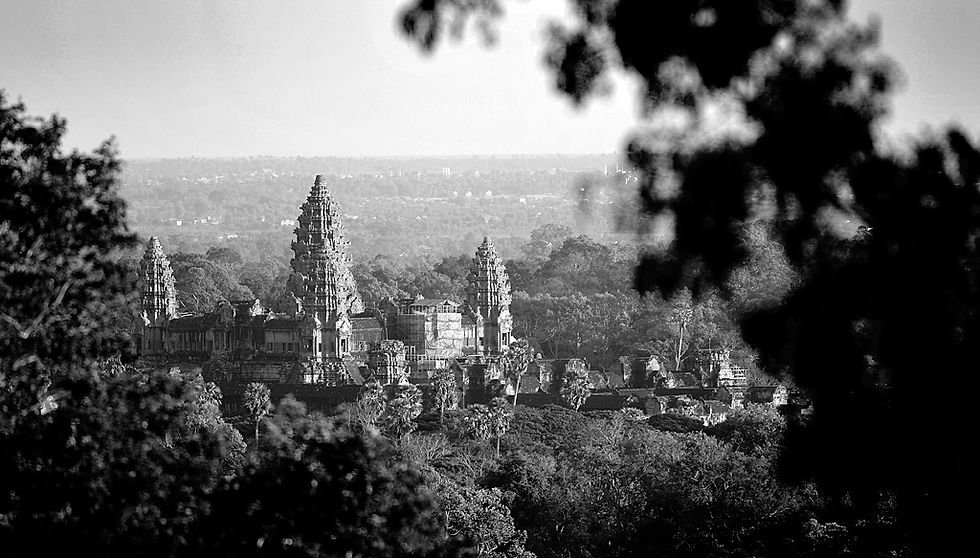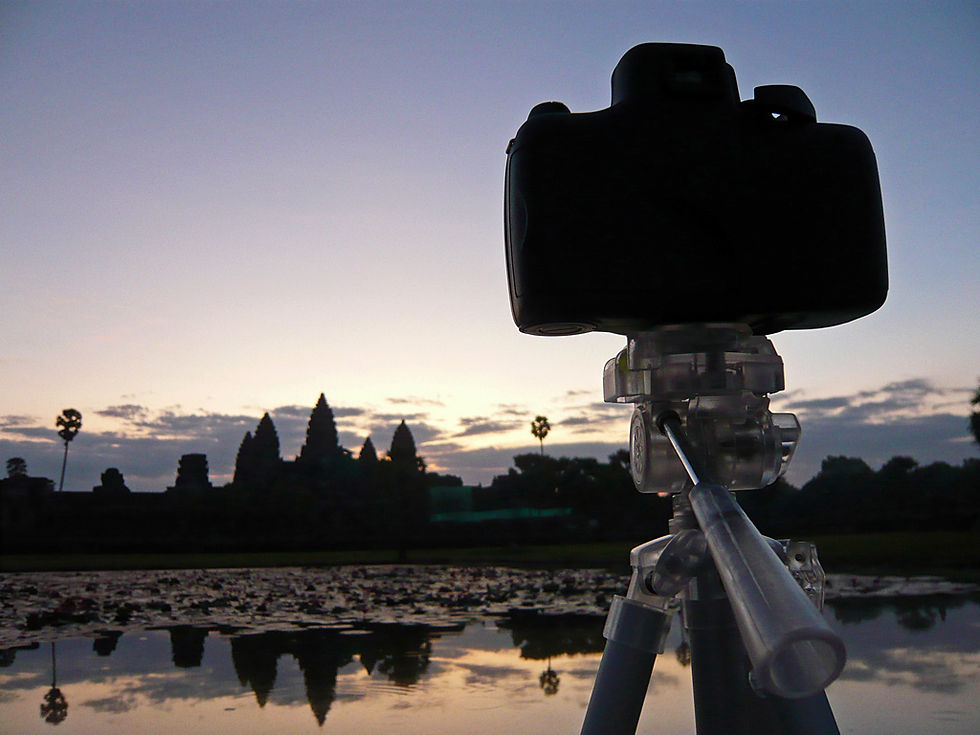I love Siem Reap so much that I had decided to make another trip there in the same year. It was also largely driven by the disappointment of arriving too late to get a good seat for Angkor Wat sunrise on the first trip. And of course, it remains a city so charming that I would love to return again and again, anytime.
Just 2 hours flight from Singapore, the city of Siem Reap is a perfect place to get away from the hustle and bustle of the Lion City, an excellent place if you are looking for an authentic historical atmosphere fused with an exotic Asian flavour. In fact, the main and perhaps only reason for some 2 million people visiting Siem Reap every year is Angkor - one of the most important archaeological sites in South-East Asia covering over 400 square kilometres of forested area, containing the magnificent remains of the different capitals of Khmer Empire from the 9th to the 15th century. Truly, it is a UNESCO World Heritage site exemplifying high levels of cultural, religious and symbolic values, as well as containing high architectural, archaeological and artistic significance.
Of course, it is not a place for everyone or could be appreciated and enjoyed by all. Many would probably still choose and repeat destinations like Bangkok, Bali or Phuket, where civilization largely prevails and offer a more diverse, fun and vibrant environment. In contrast, if reading up history, understanding architecture and experiencing culture, all excite you more than shopping centres, bars and the beaches; Siem Reap is for you.
Flying by Silkair this time, we reached Siem Reap International Airport in the late morning. The airport is small but highly efficient. It usually takes only around 20 minutes to be walking out of the airport from the time you unbuckle your plane's seatbelt.
Jumping into a taxi, we headed straight to our hotel, The Viroth's - a nice, clean and modern boutique hotel located less than 10 minute walk from the heart of town. Do note that there is no elevator in this 3 storey hotel, and the bathroom does not have any door, screen or curtain.










After getting our 3-Day temple pass done at US$40 each, we launched our itinerary with Angkor Thom, literally meaning the Great City. At more than double the size of Clementi New Town, Angkor Thom was the last capital of the Khmer Empire under King Jayavarman VII in the late 12th century. It was a fortified city enclosing residences of priests, officials of the palace and military, as well as administration buildings for the kingdom. Not forgetting important temples like the Bayon, Phimeanakas, Baphuon, Terrace of the Elephants, and Terrace of the Leper King.
We entered the Great City via the South Gate, which is probably the best preserved gate and a common point of entry coming from town. It is connected to a causeway across a moat and on each side of the causeway are railings decorated with 54 stone figures illustrating the performance of a famous Hindu story - the myth of the Churning of the Ocean. It took us more than two hours to cover the key sights within Angkor Thom, going through each of them slowly with some reading to better appreciate the monuments.
Phnom Bakheng was our next stop to catch the must-see sunset. Arriving at the foot of the hill at 4.30pm, we had more than enough time to walk and climb up the upper terrace of Phnom Bakheng before 5pm. As usual, a significant crowd had gathered at the best position and with gears set up. We managed to slot ourselves into some crevice in the crowd and watched the sun retire gradually into the Angkorian horizon outlined by the majestic landscape and legacy of an empire so powerful, so great once upon a time, that makes the setting sun appear somewhat diminutive and bowing out in humility.











The next morning, we managed wake up early and reach Angkor Wat by 5.30am to secure a good seat for the spectacular sunrise. Much better than the last trip, there were still pockets of spaces available along the edge of the lily pond for us to set up our tripods, though not at the best angle. I guess you might have to reach before 5am to have the right to choose the best spot.
By 6am, the first light had painted the sky in a hue of pastel blue and orange, still keeping the majestic temple in a gentle awakening silhouette of deep black. Within the next 15 minutes, the vast Cambodian sky was dabbled with clouds just like an impressionist painting of visible brush strokes, carefully composed, arranged and painted by God. I could now appreciate why Monet's painting, the Impression, soleil levant (Impression, Sunrise. 1872, oil on canvas) gave rise to the whole Impressionist movement.
While I was enjoying this breath-taking painting and clicking away, I turned my head around and realised that a huge crowd had gathered behind me. While you may still get a good view of the distant temple and the gorgeous sky standing behind, the main difference between the first and second row audience is that you could go low at the edge of the pond for a slightly different viewpoint. Hence, it is worth waking up early and finding a spot right at the edge of the water.
By around 6.30am, the once Impressionist sky had glowed to a vibrant radiance of light and colours, airbrushed constantly around the masked outline of the distinct Khmer architecture. The glorious sun had awakened the day by unleashing its ferocious hydrogen power with such poise and beauty as it rose slowly from the horizon. The crisp silhouette of Angkor Wat and the radiating entrance of Ra would be reflected in perfect symmetry on the lily pond by now.
The show would have come to an end by 7am, which by this time, the grounds would be deserted and sadly, littered with thrash. However, if you are not in dying need for breakfast or fainting from caffeine withdrawal, do stay around for another half an hour or so. The sun would continue to rise and bath the site and its buildings with a beautiful wash of luminous orange, dramatized with long shadows that make the buildings come alive.









After breakfast, we hopped back onto our tuk tuk and headed for Kampong Phluk, a water village located at the edge of Tonle Sap lake. In the last trip, we opted for the shorter land travel (30mins) combined with a longer boat ride (1hr 45mins). This time round, we took a 50 minute tuk tuk ride to the Rolous area, where we had to pillion on a motorcycle for another 15 minutes through a bumpy track of sand and marsh under the scorching Cambodian sun, without helmet of course. Thereafter, the boat ride took only 35 minutes to reach our destination. The first option was more comfortable, safer and more convenient. However, I would prefer the tuk tuk-motorcycle-boat package as the journey was a tad more exciting.
We spent an hour at Kampong Phluk, playing and photographing the lovely children, visiting a local school, and simply watched the locals spend the afternoon on the dry river bed.

















It was close to 3pm when we got back to town, perfect for an ice cold beer and some food. A visit to the Old Market was next, where you will see the locals selling their freshest catch at the bustling fresh food section. Narrow corridors, sometimes dark, dissect the Market into interesting nooks and corners selling clothing, bags, household wares, toys and souvenirs.
After a good walk in the Market and having our food digested, we headed to Body Tune for some much needed pampering after a long day. Finally, we wrapped up the day with some local food and culture at the Temple Club along Pub Street, where Apsara dance performances come alive every night at 8pm on the second floor.




The next morning, we embarked on some Tomb Raider adventure. The temple of Ta Prohm was used as a location in the film Lara Croft: Tomb Raider in 2001. If possible, arrive in the early morning before this solemn temple of the early 12th century gets stampede across by waves of tourists. The cotton-silk and strangler fig trees that entwine the stone structures and its carvings are fascinating to watch and intriguing to study.
Just 30 minutes away by taxi, we arrived at Banteay Srei - citadel of the women or citadel of beauty. The intricate carvings on the red sandstone make this tiny temple a worthy stop on the itinerary.
To give ourselves a break from the temples, we paid a visit to the Cambodian Landmine Museum, which was set up in 1997 by ex-child soldier Aki Ra from the Khmer Rouge Army. Upon return, he visited the villages which he had planted thousands of mines, and began removing them by hand and defusing them with homemade tools. The Museum has a good collection of exhibits, including many kinds of defused ordnance and interesting wartime images. Worth a visit to support this self-funded NGO for a good cause.









We headed back to Angkor Wat for a comprehensive tour of this magnificent temple complex. As the main entrance faces the West (hence the sun rising behind the temple), visiting in the afternoon would be ideal if you want some frontal illumination of the buildings. An hour and a half should be sufficient and comfortable for most to cover the main central structure.
If you have thoroughly covered the grounds of the temples by now and have a late afternoon to spare, why not take it to the skies for a different perspective? There are two options to see Angkor like a bird - taking the helium-filled balloon as it soar 200 metres in the air (on the same spot for 10 minutes), or choose from the many helicopter rides available which could fly you as far as the floating village.










On the following morning, our final day of the trip, we rattled to Old Market in a tuk tuk for a glimpse of the local way of life. Markets have always been a fascinating place for me to observe and appreciate the genuine local flavour - culturally, gastronomically and aromatically. And before heading to the airport, what could be better than pampering ourselves with a two hour massage at Bodia Spa, taking this chance to recap and reflect in awe this amazing empire, one which had given us one of the world's most recognisable structure, an architectural legacy of the Khmer empire that will always be greeted by the Cambodian sun first thing every morning.
Facts and Figures:
Date of Trip: December 2009
Accommodation: Viroth's Hotel
Equipment: Nikon D300, Sigma 10-20mm f4-5.6, Nikon AFS 17-55mm f2.8, Nikon AF 50mm f1.4D, Nikon AFS 70-200mm f2.8, Lensbaby Muse
Tips: Please refer to earlier post Siem Reap 2009 Part 1 (Jan).
Comentarios